
Do you have a question about the Lennox XC13-036-230-07 and is the answer not in the manual?
| Compressor Type | Scroll |
|---|---|
| Refrigerant | R-410A |
| Sound Level | 74 dB |
| Phase | 1 |
| Hertz | 60 Hz |
| Sound Level (Outdoor Unit) | 74 dB |
| Cooling Capacity | 36, 000 BTU/h |
| SEER Rating | 13 |
| Voltage | 230 V |
Identifies the unit's model number and its components for proper selection and reference.
Specifies torque values for various fasteners during installation and service to ensure proper assembly.
Details the proper use of manifold gauge sets with HFC-410A systems for diagnostics and charging.
Explains how to access and operate service valves for system maintenance and refrigerant handling.
Describes how to operate angle-type service valves for proper system access and control.
Details the operation of ball-type service valves for system manipulation.
Instructions on accessing the service port for connecting testing and charging equipment.
Guides on properly reinstalling service valve stem caps to ensure a seal.
Factors to consider when choosing the unit's placement location for optimal performance and noise.
Instructions for setting up the unit on a foundation slab to ensure stability and levelness.
Methods for raising the unit using extenders for proper height and clearance.
Illustrates proper placement of the outdoor unit away from windows for optimal operation.
Explains slab mounting and slope tolerance for ground-level unit installations.
Shows how to use feet extenders for elevated slab mounting and leveling.
Describes side mounting to a slab using brackets for stability.
Illustrates the procedure for mounting the unit on a deck.
Warns about potential damage to roofing material from oil and refrigerant exposure.
Step-by-step guide to safely remove louvered access panels from the unit.
Step-by-step guide to correctly install louvered access panels onto the unit.
Provides information on installing or replacing refrigerant line sets for system compatibility.
Details methods for isolating refrigerant lines to reduce noise and vibration transmission.
Illustrates proper isolation for vertical to horizontal line set transitions.
Demonstrates correct installation procedures for vertical refrigerant line runs.
Details proper installation methods for horizontal refrigerant line runs.
Recommends silver alloy brazing rods for copper-to-copper and copper-to-metal joints.
Instructions for cutting and deburring refrigerant line ends to prepare for brazing.
Steps for removing service port caps and cores before initiating brazing.
Details connecting the manifold gauge set for brazing with nitrogen flow protection.
Describes wrapping service valves with wet cloths to protect them during brazing.
Instructions for flowing nitrogen through the system during brazing for protection.
Explains the core procedure for brazing the line set to the unit's service valves.
Steps to take after brazing is complete before proceeding to subsequent procedures.
Details removing a fixed orifice metering device from the indoor coil.
Details removing an expansion valve metering device from the indoor coil.
Explains how to connect gauges and equipment for the flushing procedure.
Describes the process of flushing the line set and indoor coil for system cleanliness.
Step-by-step guide for installing an indoor expansion valve metering device.
Instructions for installing the equalizer line for the expansion valve connection.
Details correct mounting and placement of the sensing bulb for TXV operation.
Explains why flushing is required for systems previously using mineral oil for warranty.
Specifies requirements for the leak detector used for HFC refrigerants.
Details connecting the manifold gauge set for system leak testing.
Step-by-step procedure for checking the system for refrigerant leaks.
Details connecting gauges and equipment for system evacuation procedures.
Step-by-step instructions for evacuating the refrigerant lines and coil to remove air.
Specifies the type of vacuum gauge required for accurate measurement during evacuation.
Guides on selecting and installing the correct circuit disconnect switch per code.
Instructions for installing the room thermostat at an optimal location for control.
Details the low voltage wiring connections for unit control and operation.
Guides on connecting the gauge set for system testing and refrigerant charging.
Procedures for checking and adjusting indoor unit airflow for optimal performance.
Instructions for adding or removing refrigerant from the system.
How to determine the target Delta-T for airflow measurement.
Measures the temperature difference across the indoor coil for airflow analysis.
Assesses if fan speed adjustment is required based on airflow measurements.
Instructions for adjusting the indoor fan speed to meet system requirements.
Describes key components and their functions within the unit for operational understanding.
Explains the function and operation of the high-pressure switch as a safety feature.
Details the discharge line thermal protection switch that prevents compressor damage.
Describes the compressor-mounted thermal protection switch for overheating protection.
Explains the function of the crankcase thermostat for compressor protection.
Information regarding the compressor's internal vacuum protector behavior.
Maintenance tasks to be performed by dealers or qualified service agencies.
Steps for maintaining the outdoor unit, including cleaning and inspection.
Specific cleaning and inspection procedures for the outdoor coil.
Maintenance tasks to be performed on the indoor unit.
Maintenance tasks that homeowners can perform to maintain the system.
General routine maintenance advice for ensuring optimal system performance.
Checklist of items to verify before contacting service for troubleshooting.
Lists related publications for additional information on Lennox products.





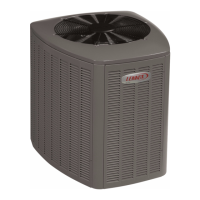
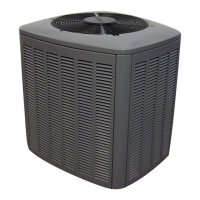
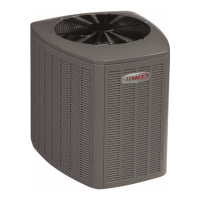

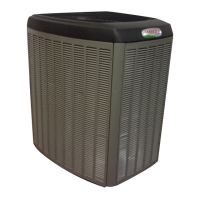
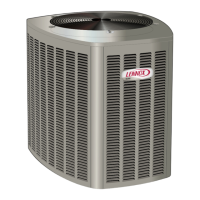
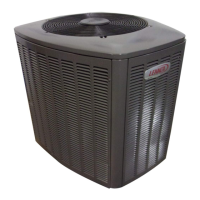
